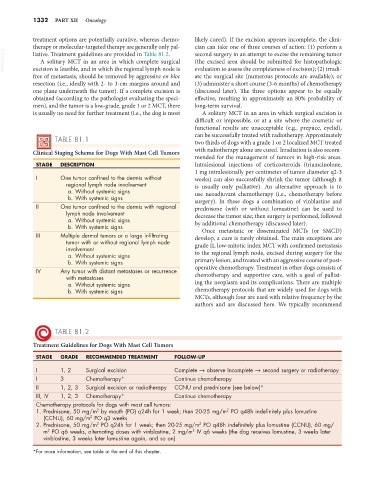Page 1360 - Small Animal Internal Medicine, 6th Edition
P. 1360
1332 PART XII Oncology
treatment options are potentially curative, whereas chemo- likely cured). If the excision appears incomplete, the clini-
therapy or molecular-targeted therapy are generally only pal- cian can take one of three courses of action: (1) perform a
VetBooks.ir liative. Treatment guidelines are provided in Table 81.2. second surgery in an attempt to excise the remaining tumor
(the excised area should be submitted for histopathologic
A solitary MCT in an area in which complete surgical
excision is feasible, and in which the regional lymph node is
free of metastasis, should be removed by aggressive en bloc evaluation to assess the completeness of excision); (2) irradi-
ate the surgical site (numerous protocols are available); or
resection (i.e., ideally with 2- to 3-cm margins around and (3) administer a short course (3-6 months) of chemotherapy
one plane underneath the tumor). If a complete excision is (discussed later). The three options appear to be equally
obtained (according to the pathologist evaluating the speci- effective, resulting in approximately an 80% probability of
men), and the tumor is a low-grade, grade 1 or 2 MCT, there long-term survival.
is usually no need for further treatment (i.e., the dog is most A solitary MCT in an area in which surgical excision is
difficult or impossible, or at a site where the cosmetic or
functional results are unacceptable (e.g., prepuce, eyelid),
can be successfully treated with radiotherapy. Approximately
TABLE 81.1 two thirds of dogs with a grade 1 or 2 localized MCT treated
Clinical Staging Scheme for Dogs With Mast Cell Tumors with radiotherapy alone are cured. Irradiation is also recom-
mended for the management of tumors in high-risk areas.
STAGE DESCRIPTION Intralesional injections of corticosteroids (triamcinolone,
1 mg intralesionally per centimeter of tumor diameter q2-3
I One tumor confined to the dermis without weeks) can also successfully shrink the tumor (although it
regional lymph node involvement is usually only palliative). An alternative approach is to
a. Without systemic signs use neoadjuvant chemotherapy (i.e., chemotherapy before
b. With systemic signs surgery). In these dogs a combination of vinblastine and
II One tumor confined to the dermis with regional prednisone (with or without lomustine) can be used to
lymph node involvement decrease the tumor size; then surgery is performed, followed
a. Without systemic signs
b. With systemic signs by additional chemotherapy (discussed later).
Once metastatic or disseminated MCTs (or SMCD)
III Multiple dermal tumors or a large infiltrating develop, a cure is rarely obtained. The main exceptions are
tumor with or without regional lymph node
involvement grade II, low-mitotic index MCT with confirmed metastasis
a. Without systemic signs to the regional lymph node, excised during surgery for the
b. With systemic signs primary lesion, and treated with an aggressive course of post-
IV Any tumor with distant metastases or recurrence operative chemotherapy. Treatment in other dogs consists of
with metastases chemotherapy and supportive care, with a goal of palliat-
a. Without systemic signs ing the neoplasm and its complications. There are multiple
b. With systemic signs chemotherapy protocols that are widely used for dogs with
MCTs, although four are used with relative frequency by the
authors and are discussed here. We typically recommend
TABLE 81.2
Treatment Guidelines for Dogs With Mast Cell Tumors
STAGE GRADE RECOMMENDED TREATMENT FOLLOW-UP
I 1, 2 Surgical excision Complete → observe Incomplete → second surgery or radiotherapy
I 3 Chemotherapy* Continue chemotherapy
II 1, 2, 3 Surgical excision or radiotherapy CCNU and prednisone (see below)*
III, IV 1, 2, 3 Chemotherapy* Continue chemotherapy
Chemotherapy protocols for dogs with mast cell tumors:
2
2
1. Prednisone, 50 mg/m by mouth (PO) q24h for 1 week; then 20-25 mg/m PO q48h indefinitely plus lomustine
(CCNU), 60 mg/m PO q3 weeks
2
2. Prednisone, 50 mg/m PO q24h for 1 week; then 20-25 mg/m PO q48h indefinitely plus lomustine (CCNU), 60 mg/
2
2
m PO q6 weeks, alternating doses with vinblastine, 2 mg/m IV q6 weeks (the dog receives lomustine, 3 weeks later
2
2
vinblastine, 3 weeks later lomustine again, and so on)
*For more information, see table at the end of this chapter.

